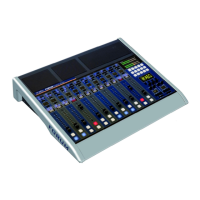AEQ FORUM
Digital audio mixer for broadcast applications
43
When establishing the settings, the threshold for the noise gate will be much lower than in the
case of the compressor, as its operation is the opposite. The noise gate prevents the passing of
lower levels of the signal that could be considered noise. Therefore, the range of settings is
different. In addition, there is an additional parameter for noise gates, which is “Hold Time.” This
is a safety period used to prevent the gate from accidentally closing if a signal is suddenly
absent, for example, in speech.
In addition, the threshold must be adjusted to a level slightly higher than the level of the noise to
be avoided. Thus, the threshold will be set at a very low level. Above the threshold, the noise
gate does not act (unity gain), letting the rest of the signal through without processing it. The
gate remains closed; i.e. when the signal surpasses the threshold level, the gate opens. The
attack time is the time the gate takes to open (unity gain) when it receives a signal whose
amplitude exceeds the threshold level; this time must be short to avoid cutting off the beginning
of a sentence or song. The release time is the time the gate takes to close when the signal level
falls below the threshold. The hold time is the minimum time during which the gate remains
open; it is used to prevent the gate from closing when the signal level drops briefly—for
example, when an announcer pauses while speaking. The hold time prevents the gate from
opening and closing constantly in the presence of a signal whose level fluctuates in a range
close to the threshold level.
The “NGATE” contextual key enables you to activate the noise gate whose parameters are
shown at that time on the screen. The activation of the noise gate is confirmed by the activation
of the LED of the contextual key and the LED ”DYN” of the selected mixer channel (see section
“2.1.1.5. Indicators of active processes” of this manual). The “NGATE” contextual key also
enables you to return to the Noise Gate menu when you are in the Compressor/Limiter menu (in
that case, the associated LED lights for a moment and then it turns off).
3.4.3.1.2 Equalizer and filter menu.
Pressing the “EQUAL” contextual key from the advanced information menu of an audio input
channel will give you access to the menu to configure the equalizer and filters.
The upper part of the screen shows the channel identifier name and the middle area of the
screen shows the graphic representation of the response curve of the equalizer and filters that
are active at that time.
The four options visible on the last line of the display are associated with the four contextual
keys below, from left to right:
• “BACK”: pressing this key allows you to return to the previous menu screen.
• “HPF”: allows you to activate the configured high pass filter (the associated LED will
light). Pressing this contextual key for three seconds opens the cut-off frequency
configuration menu: this configuration is accomplished by turning the first associated
encoder and pressing the “BACK” contextual key to return to the previous screen once
this parameter is configured (between 20 and 1000Hz).

